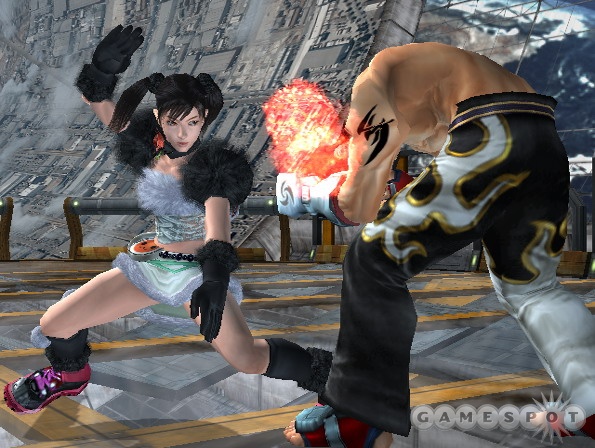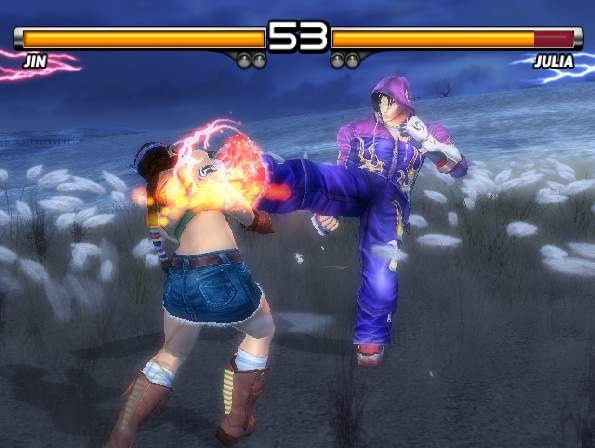It seems hard to believe, but the Tekken series has been around for about a decade now. In that period, Tekken became one of the premier 3D fighting games in arcades, but its real fame was found at home. The PlayStation, and later the PlayStation 2, has been the Tekken series' stomping grounds for the past 10 years, and traditionally, the home versions have managed to outperform their impressive arcade counterparts. That grand tradition holds true in Tekken 5, which offers additional modes not found in the arcade original, but even more importantly, it offers fantastic 3D fighting and stunning visuals.

Tekken 5 sort of pretends that Tekken 4 never happened. The previous installment introduced a handful of position-change moves that weren't terribly well received. Tekken 5 takes a back-to-basics approach and removes those moves, making for a game that feels and plays more like the classic Tekken 3 did. The uneven floors you'd sometimes find in Tekken 4 are also gone. Some arenas do have walls, however, and you can still use these to set up some interesting combos. In short, Tekken 5 might not be a total reinvention of the series, but considering just how well it plays now, if Tekken had been rebuilt from the ground up it would likely have been a huge mistake. The fighting in Tekken 5 is some of the best fighting available in 3D or 2D, and its multiple levels of depth give beginners enough flashy moves to quickly feel comfortable playing it, while intermediate and expert players can dig deeper and deeper to find more interesting (and damaging) techniques.
The main single-player mode of play in Tekken 5 is the story mode. This mode takes you through a handful of fights, starting with some still frames and voice-over to help you understand what each individual fighter is fighting for. Along the way, you'll square off with some fighters that are tied to that story, giving you some pre- and post-fight dialogue. When you reach the story's conclusion, you are given some static screens with text and a full-fledged, prerendered ending for each character. Tekken's prerendered endings have always been one of the most memorable aspects of the series, and this collection of occasionally serious but often hilarious endings are among the series' best. It's a fun look at the characters that you don't normally get in the context of a fighting game, and helps give the impression that whoever made Tekken 5 must have had a lot of fun along the way.
Tekken 5 has many of the same character-customization options found in Virtua Fighter 4. You can alter most of the characters (the inability to customize the wooden training dummy Mokujin seems like a missed opportunity for comedy, though) using currency you earn as you keep playing. Some of the changes you can make are simple color tweaks to the characters' outfits, but you can also pick up accessories, such as sunglasses, necklaces, or a basket full of fish for kung-fu master Wang's back. Each character has unique customization options, and the options are different for each of a character's two primary costumes. Some characters also have a third costume that can be purchased, and some of these are just new outfits. Capoiera mistress Christie's third costume is an entirely different (though obviously familiar) character, who gets his own story mode intro and ending when selected.
The arcade mode is where you'll earn your gold, and it's sort of an endless arcade-style battle against the game's artificial intelligence. Much like Virtua Fighter 4 did before it, Tekken 5 pits you against AI players of different ranks that have actual ring names, as if they were based on actual players. As you play arcade mode, you'll rank up each individual character through multiple classes. The ring name and character rank stuff is neat, but it isn't implemented in a very user-friendly manner, as only one player per memory card can enter a name and track his or her player rank.
While you probably won't mistake Tekken 5's AI for another human being, the fighters do take on slightly different styles and are generally more competent than the average computer-controlled fighter. With five difficulty settings to choose from, fight fans of all skill levels should find something that tests their capabilities here. The strong AI helps make up for Tekken 5's lack of online play, but the lack of network support is still a disappointing omission, especially considering that Tekken 5 packs in pretty much everything else.

The character roster in Tekken 5 contains a great mix of old favorites, some of whom haven't been seen for years. The obvious entrants, like Kazuya, Paul, Law, Yoshimitsu, King, and Nina are present, and they're joined by other occasional players, like Bryan, Lei, Hwoarang, Bruce, Baek, Anna, Lee, and Xiaoyu. Tekken 4's new introductions, Steve, Marduk, and Christie are back, and three new characters make their first appearance here: Raven is a Wesley Snipes as Simon Phoenix-like assassin that combines powerful moves with shifty, tricky behavior, up to and including the ability to teleport in some moves; Asuka is a schoolgirl, and she's also a Kazama, making her Jin's cousin and a master of the Kazama style and similar (though definitely not identical) to Jun; Feng is an evil kenpo master that enters the tournament to find some sacred scrolls that the Mishima Zaibatsu controls. The roster is diverse and exciting and it hits all the bases. The new characters fit into the action very well, and the old characters have all received enough new moves and changes to feel fresh again, though not so many that the move list will feel unrecognizable.
The Tekken series has been putting in weird offshoot modes for years now. This year's model contains a new story known as Devil Within. This story-driven mode puts you in control of Jin as he raids the Mishima Zaibatsu and G Corporation's headquarters, smashing up enemy robots along the way. The fighting has been extremely simplified for this behind-the-back mode, and you're given a lock-on button that lets you make sure you're always targeting one foe. You're always outnumbered, though, so locking on is less effective than simply dishing out damage to everything within the reach of your hands and feet. Devil Within is a neat idea that's executed about as well as you'd expect for a minor extra, but with its stripped-down fighting, cookie-cutter corridors, and monotonous platforming, it's not the sort of thing you'll come back to time and time again.
You might come back to the arcade history mode, which, right off the bat, gives you access to the arcade versions of the original Tekken, Tekken 2, and Tekken 3. These serve as an excellent reminder of how far the series has come over the years, but more importantly, it reminds you that these games still play very well. It's tough to go all the way back to the first game, but Tekken 2 and Tekken 3 are still very, very playable. They also don't have any loading time between fights, which is cool. In fact, even when Tekken 5 does stop to load, the load times are nice and fast, which really helps to keep you in the action. It also probably helps make the game so addictive, since you aren't given too much time to think about anything else between fights.
The fighters in Tekken 5 hit hard. That's one of the major factors that makes the game look so fantastic. The moves look like they hurt. This is something that many other fighting games seem to miss, but here, even the most basic dashing punch moves practically look like they're capable of shattering every bone in your body. Part of that is due to the great-looking particle effects that blast off of heavy hits, but a great deal of it is also due to the game's outstanding animation. The characters move extremely fluidly, and the motion-captured movements are really, really cool, even though some of them have been recycled from previous games.
When it comes to image quality and character models, you'd be hard pressed to find a better looking PlayStation 2 game than this. Tekken 5 looks simply astounding--way above and beyond what you would think the PlayStation 2 is capable of. The character models are smooth and lifelike, with skin tones and textures that make them look alive, as opposed to the plastic-looking fighters found in some other games. The backgrounds are widely varied, and some of them are even breathtaking. Again, it's the sort of stuff you'd expect from a high-end Xbox title or a great-looking PC game--not something you'd expect from the PlayStation 2 hardware. From the fight arena that surrounds you with bloodthirsty onlookers and their van--which happens to be hanging from a hook a few feet above the ground--to the inside of a temple that happens to be on fire, you'll find a wide variety of amazing stuff here. This may be the PlayStation 2's best-looking game to date, and it's hard to imagine anything else topping it this far along in the cycle. Support for widescreen displays and progressive scan support only helps to make the image look that much better. But make no mistake, Tekken 5 looks incredible regardless of the mode you run it in, and the quality of the visuals of course helps make the action itself that much better.
Tekken's soundtrack has usually consisted of a particular style of electronic music that fits the action, but it was never particularly memorable and it got a little tiresome over time. Tekken 5's soundtrack is much more varied than that of its predecessors, and this variety meshes very well with each individual background in the game. There's also a load of speech in Tekken 5, and it's all really good. Each character speaks in his or her own native language, which is a great touch. It's also really funny in some cases, such as when you have Kuma speaking in subtitled bear growls that the other characters can somehow understand in a weird, Lassie-style sort of way. And wait until you see Mokujin and boxing kangaroo Roger Jr. converse in their "native" tongues.

Also, we have to give some of the credit for the game's hard-hitting moves to the sound effects. You can expect to hear many of the same snaps and cracks that you've heard in previous games, but this time there's a lot more bass. The thundering low end on some of the strikes definitely makes the impacts sound as damaging as they look.
A big part of Tekken 5's appeal is due to the quality of its execution. While some of the extra modes aren't as strong as they could have been, the core fighting is nearly perfect, whether you're playing against other humans or computer-controlled opposition. Toss in a fantastic soundtrack and some of the best-looking graphics you've seen on a console, along with an insane number of different moves to learn and master from a variety of interesting characters, and you've got a fighting game that's even more addictive and exciting than Tekken was when it exploded onto the PlayStation back in 1995.
